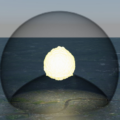Astronomers utilizing the European Southern Observatory’s (ESO) Very Large Telescope (VLT) report the discovery of the tiniest stellar oscillation, or “starquake,” ever witnessed. Named Epsilon Indi, the star is the coolest dwarf star yet to display stellar oscillations like those exhibited by our own Sun, with its surface temperature roughly 1000 degrees Celsius cooler than the Sun’s.
When properly detected, a starquake can reveal invaluable data about the interior composition of a star, just like earthquakes can reveal information about the Earth. The researchers behind the first-ever detection are labeling it a huge step forward for the field of asteroseismology.
The discovery was an international effort led by researchers from the Institute of Astrophysics and Space Sciences in Portugal, with contributions from researchers at the University of Birmingham.
Tiniest Starquake Measurement a Major Step for Asteroseismology
To spot the tiniest starquake ever recorded, the team tapped into the data-gathering power of the VLT’s Echelle SPectrograph for Rocky Exoplanets and Stable Spectroscopic Observations (ESPRESSO spectrograph.) According to the ESO’s project page, ESPRESSO “is an ultra-stable fibre-fed échelle high-resolution spectrograph (R~140,000, 190,000, or 70,000) which collects the light from either a single UT or the four UTs simultaneously via the so-called UT Coudé trains.” This means that the researchers were not only able to detect the tiny starquake but were able to measure it “with unprecedented precision.”
“The extreme precision level of these observations is an outstanding technological achievement,” said the study’s lead author, Tiago Campante, of the Institute of Astrophysics and Space Sciences at the University of Porto.
Campante also notes that the team’s starquake detection shows that highly precise asteroseismology is possible all the way down to cool dwarfs with surface temperatures as low as 4200 degrees Celsius, about 1000 degrees cooler than the Sun’s surface, “effectively opening up a new domain in observational astrophysics.”
Published in the journal Astronomy and Astrophysics Supplement Series, the team’s discovery could add valuable data in the search for habitable zone planets that could harbor life. That’s because cooler orange dwarf stars like Epsilon Indi have become intriguing places to search for such planets.
“The mismatch between the predicted and observed sizes of these stars has implications for finding planets around them,” explained Professor Bill Chaplin, Head of the School of Physics & Astronomy at Birmingham and a member of the team. “If we use the most successful planet-finding technique – the so-called transit method – we get the size of the planet relative to the size of the star; if we don’t size up the star correctly, the same will be true of any small planet we have found.”
Measurement to Aid Upcoming PLATO Mission in Search of Habitable Planets
Looking ahead, the researchers say their discovery will help planners of the European Space Agency’s (ESA) upcoming PLAnetary Transits and Oscillations of stars (PLATO) mission. Planned for a 2026 launch, PLATO will be specifically tasked with searching for habitable planets around this class of stars.
According to the PLATO mission page, the project’s primary goal “is to open a new way in exoplanetary science by detecting terrestrial exoplanets and characterizing their bulk properties, including planets in the habitable zone of Sun-like stars.”
The mission page concludes, “PLATO will answer the profound and captivating question: How common are worlds like ours, and are they suitable for the development of life?”
Christopher Plain is a Science Fiction and Fantasy novelist and Head Science Writer at The Debrief. Follow and connect with him on X, learn about his books at plainfiction.com, or email him directly at christopher@thedebrief.org.

